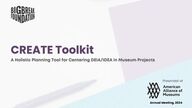
Return to flip book view
Presented atAnnual Meeting, 2024
About this ToolkitWhen To Use This ToolkitThis toolkit is most effective when it’s introduced at thestart of a project, however it can also be implemented inlater stages.Preparing To Use This ToolkitEnsure key decision makers are committed to prioritizingdiversity, equity, inclusion and accessibility at every stageof the project. Start by aligning on clear goals that reflectthese values.LimitationsWhile this toolkit focuses on equitable project planning, itshould be noted that a sustainable IDEA practice starts byaddressing structural and systemic barriers within ourorganizations. CREATE ModelOverviewToolkit at a GlanceAudio ExplainersResource GuidesInteractivesWorksheetsTools &Frameworks
CREATEModelRATEECCOLLABORATEREFLECTENGAGEACTTRACKEVOLVE
CREATEModelCRATEECollaborateREFLECTENGAGEACTTRACKEVOLVECollaborateWe co-create equitable internal practices, policies andprocesses, and extend this beyond the boundaries of ourinstitutions.We engage in participatory design of solutions thatadvance justice, drive positive impact, and empower thevoices that have gone unheard.EquitableCo-creation:ReflectionWho Speaksfor theCommunity?Worksheet Worksheet
Click to preview
Guiding QuestionsDo our current partnerships advance our commitment to IDEA?At what stage of a project do we begin co-creating with communityadvisors/representatives?How do we determine who gets to speak on behalf of a community?Are we compensating co-creators for their time and expertise?
CREATEModelWe actively reflect on our identities, privileges and barriers,and how our intersectional experiences impact how weshow up in our lives and at work.We examine where we are collectively as an organization.We celebrate our strengths and acknowledge where weneed to grow.CRATEEREFLECTENGAGEACTTRACKEVOLVEReflectCollaborateIntersectionalWheel ofPrivilegeIDEAEcosystemsWorksheet ModelIDEA BaselineAssessmentAssessment
Click to preview
Guiding QuestionsHow do our identities influence or inform our designs?Does our project team equitably reflect the diversity in ourcommunities?Is our commitment to IDEA reflected in our policies, practices andprocesses?What assumptions are we making about our visitors’ identities,experiences and abilities?
CREATEModelCRATEEREFLECTENGAGEACTTRACKEVOLVEEngageWe create space for brave conversations within ourinstitutions, with our partners, and with the members ofthe communities that we serve.We take measures to include and uplift marginalizedvoices, and we’re transparent about where we are andwhere we need to go.CollaborateGuiding IDEAQuestionsGuide WorksheetTeam Norms& Agreements
Guiding QuestionsWhose perspective is missing from key decision-making teams?Whose voices are we elevating? Are we building a culture of transparency?Do we foster a culture that encourages feedback, regardless of role orseniority?
CREATEModelCRATEEREFLECTENGAGEACTTRACKEVOLVEActWe align on co-created, equitable solutions and workconsistently towards them.We hold ourselves accountable to addressing thesystemic barriers within our institutions.CollaborateIDEA StrategicPlanningTemplateWorksheet
Guiding QuestionsDo we work consistently to address the systemic barriers within ourinstitutions and beyond?Are we actively integrating the input of our collaborators/co-creators?Are we accounting for IDEA needs in our timelines and budgets?Is IDEA regarded as a project add-on, or a project priority?
CREATEModelCRATEEREFLECTENGAGEACTTRACKEVOLVETrackWe monitor IDEA metrics and key measures of successas we would other mission-critical initiatives.We regularly assess desired progress against actualprogress and adjust accordingly.CollaborateGuidance onMetrics andKPIsValues-DrivenProjectTrackingGuide WorksheetIDEA BaselineAssessmentAssessment
Guiding QuestionsHow are we defining success?How are we measuring it?How are we holding ourselves accountable to advancing IDEA in ourorganizations?Are we regularly assessing our desired progress against our actualprogress?
CREATEModelCRATEEREFLECTENGAGEACTTRACKEVOLVEEvolveCollaborateWe continue to iterate on our IDEA practices,understanding that it’s not a fixed destination, butrather, an integral part of how we work and show up forour communities.ProjectRetrospective Worksheet
Guiding QuestionsDo we build in checkpoints to assess and iterate on our IDEA efforts?Have we laid the groundwork to continue evolving our IDEA practicessustainably?If we fail to meet a IDEA goal, how do we respond?What tools/resources do we realistically need to support future efforts?
Design Justice PrinciplesDiversity, Equity, Accessibility, and Inclusion(DEAI) BookletAdditional ResourcesMeasuring InclusionMASS Action Readiness AssessmentMuseums as a Site for Social ActionBuilding Salary Equity at Bakken MuseumOMSI Equity Action Framework
Download Presentation Slides
nicolle@bigbreakfoundation.orgEMAILSOCIALWEBSITEbigbreakfoundation.orgChat With Big Break